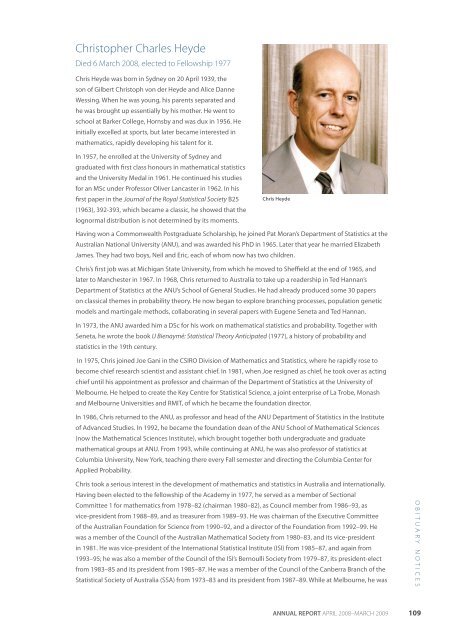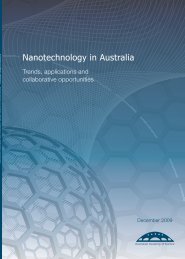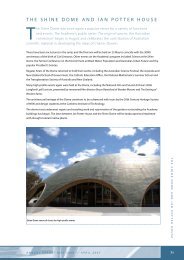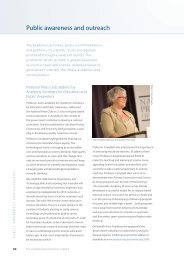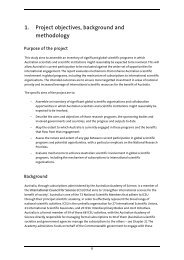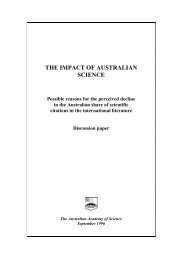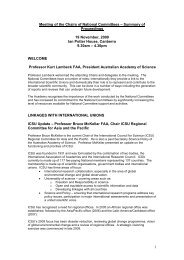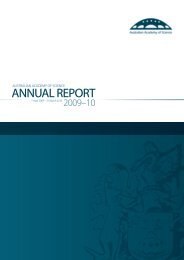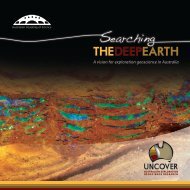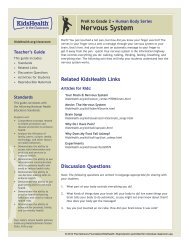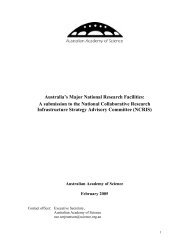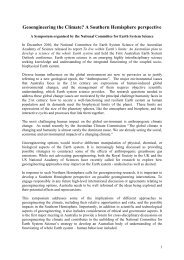full report - Australian Academy of Science
full report - Australian Academy of Science
full report - Australian Academy of Science
Create successful ePaper yourself
Turn your PDF publications into a flip-book with our unique Google optimized e-Paper software.
Christopher Charles Heyde<br />
Died 6 March 2008, elected to Fellowship 1977<br />
Chris Heyde was born in Sydney on 20 April 1939, the<br />
son <strong>of</strong> Gilbert Christoph von der Heyde and Alice Danne<br />
Wessing. When he was young, his parents separated and<br />
he was brought up essentially by his mother. He went to<br />
school at Barker College, Hornsby and was dux in 1956. He<br />
initially excelled at sports, but later became interested in<br />
mathematics, rapidly developing his talent for it.<br />
In 1957, he enrolled at the University <strong>of</strong> Sydney and<br />
graduated with first class honours in mathematical statistics<br />
and the University Medal in 1961. He continued his studies<br />
for an MSc under Pr<strong>of</strong>essor Oliver Lancaster in 1962. In his<br />
first paper in the Journal <strong>of</strong> the Royal Statistical Society B25<br />
(1963), 392-393, which became a classic, he showed that the<br />
lognormal distribution is not determined by its moments.<br />
Chris Heyde<br />
Having won a Commonwealth Postgraduate Scholarship, he joined Pat Moran’s Department <strong>of</strong> Statistics at the<br />
<strong>Australian</strong> National University (ANU), and was awarded his PhD in 1965. Later that year he married Elizabeth<br />
James. They had two boys, Neil and Eric, each <strong>of</strong> whom now has two children.<br />
Chris’s first job was at Michigan State University, from which he moved to Sheffield at the end <strong>of</strong> 1965, and<br />
later to Manchester in 1967. In 1968, Chris returned to Australia to take up a readership in Ted Hannan’s<br />
Department <strong>of</strong> Statistics at the ANU’s School <strong>of</strong> General Studies. He had already produced some 30 papers<br />
on classical themes in probability theory. He now began to explore branching processes, population genetic<br />
models and martingale methods, collaborating in several papers with Eugene Seneta and Ted Hannan.<br />
In 1973, the ANU awarded him a DSc for his work on mathematical statistics and probability. Together with<br />
Seneta, he wrote the book IJ Bienaymé: Statistical Theory Anticipated (1977), a history <strong>of</strong> probability and<br />
statistics in the 19th century.<br />
In 1975, Chris joined Joe Gani in the CSIRO Division <strong>of</strong> Mathematics and Statistics, where he rapidly rose to<br />
become chief research scientist and assistant chief. In 1981, when Joe resigned as chief, he took over as acting<br />
chief until his appointment as pr<strong>of</strong>essor and chairman <strong>of</strong> the Department <strong>of</strong> Statistics at the University <strong>of</strong><br />
Melbourne. He helped to create the Key Centre for Statistical <strong>Science</strong>, a joint enterprise <strong>of</strong> La Trobe, Monash<br />
and Melbourne Universities and RMIT, <strong>of</strong> which he became the foundation director.<br />
In 1986, Chris returned to the ANU, as pr<strong>of</strong>essor and head <strong>of</strong> the ANU Department <strong>of</strong> Statistics in the Institute<br />
<strong>of</strong> Advanced Studies. In 1992, he became the foundation dean <strong>of</strong> the ANU School <strong>of</strong> Mathematical <strong>Science</strong>s<br />
(now the Mathematical <strong>Science</strong>s Institute), which brought together both undergraduate and graduate<br />
mathematical groups at ANU. From 1993, while continuing at ANU, he was also pr<strong>of</strong>essor <strong>of</strong> statistics at<br />
Columbia University, New York, teaching there every Fall semester and directing the Columbia Center for<br />
Applied Probability.<br />
Chris took a serious interest in the development <strong>of</strong> mathematics and statistics in Australia and internationally.<br />
Having been elected to the fellowship <strong>of</strong> the <strong>Academy</strong> in 1977, he served as a member <strong>of</strong> Sectional<br />
Committee 1 for mathematics from 1978–82 (chairman 1980–82), as Council member from 1986–93, as<br />
vice-president from 1988–89, and as treasurer from 1989–93. He was chairman <strong>of</strong> the Executive Committee<br />
<strong>of</strong> the <strong>Australian</strong> Foundation for <strong>Science</strong> from 1990–92, and a director <strong>of</strong> the Foundation from 1992–99. He<br />
was a member <strong>of</strong> the Council <strong>of</strong> the <strong>Australian</strong> Mathematical Society from 1980–83, and its vice-president<br />
in 1981. He was vice-president <strong>of</strong> the International Statistical Institute (ISI) from 1985–87, and again from<br />
1993–95; he was also a member <strong>of</strong> the Council <strong>of</strong> the ISI’s Bernoulli Society from 1979–87, its president-elect<br />
from 1983–85 and its president from 1985–87. He was a member <strong>of</strong> the Council <strong>of</strong> the Canberra Branch <strong>of</strong> the<br />
Statistical Society <strong>of</strong> Australia (SSA) from 1973–83 and its president from 1987–89. While at Melbourne, he was<br />
OBITUARY NOTICES<br />
ANNUAL REPORT APRIL 2008–MARCH 2009 109


